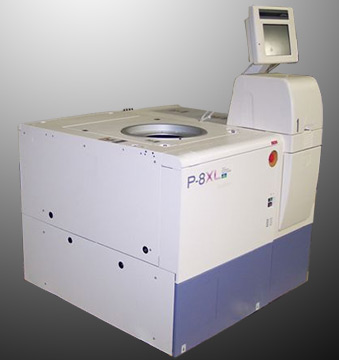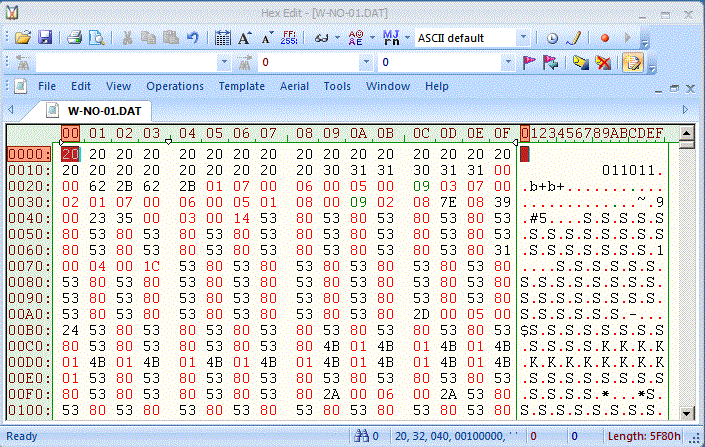WWF
This format was developed by Texas Instruments. Details ...
Header
FACILITY=OEMNAME Facility ID
LOT=99XXX.1 Lot ID
DEVICE=CMD252EUBMB4 Device ID
WAFERS=01 Number of Wafers in this file
X_SIZE=123.228 Die Size in X (units appear to be mils
Y_SIZE=123.228 Die Size in Y (units appear to be mils
SCRIBE="BOTTOM,15,NTRL,FAB" Location of scribed data?
WAFER_SIZE=150 Wafer diameter in mm
STATUS="PROD" Status
USER="NOINK" User or user defined info
BIN_NAME.01="G,WQLPASS" Bin category
BIN_NAME.09="WQLFAIL" Bin category
This is followed by a section called a shot map. This is a listing of all die. Notice that for each Y row (ranging from -21 to 20) there is a "list" of X locations.
SHOT_MAP="Y-21 12/31 Y-20 10/33 Y-19 9/34 Y-18 8/35 Y-17 7/36
Y-16 6/37 Y-15 5/38 Y-14 4/39 Y-13 3/40 Y-12 3/40 Y-11 2/41 Y-10 2/41 Y-9 1/42
Y-8 1/42 Y-7 1/42 Y-6 0/43 Y-5 0/43 Y-4 0/43 Y-3 0/19 24/43 Y-2 0/19 24/43
Y-1 1/19 24/42 Y0 1/19 24/42 Y1 1/42 Y2 1/42 Y3 1/42 Y4 1/42 Y5 1/42 Y6 1/42
Y7 2/41 Y8 2/41 Y9 3/40 Y10 3/40 Y11 4/39 Y12 5/38 Y13 5/38 Y14 6/37 Y15 7/36
Y16 8/35 Y17 10/33 Y18 11/32 Y19 13/30 Y20 16/27"
Now the wafer population is defined, the number of bins is declared and a BIN (previously defined) referred to. That is followed by all the die positions belonging to this bin.
WAFERID.01=LG991-01-E4
NUM_BINS.01=02
BIN_COUNT.01.01=01313
MAP_XY.01.01="Y-21 12/18 20/28 30/31 Y-20 10/12 15/33 Y-19 9/34
Y-18 8/13 16/35 Y-17 7/13 16/22 24/27 29/35 Y-16 6/13 15/37 Y-15 5/8 10/13
16/31 33/37 Y-14 4/13 16/39 Y-13 4/13 16/26 28/40 Y-12 4/12 16/40 Y-11 2/5 7
9/12 16/41 Y-10 2/8 10/13 16 18/24 26/37 39/41 Y-9 1/13 16/42 Y-8 1/13 17/42
Y-7 2/13 17/25 27/42 Y-6 0/13 17/43 Y-5 0/13 18/43 Y-4 0/14 17/43 Y-3 0/7 9/14
17/19 24/43 Y-2 0/14 17 19 24/41 43 Y-1 1 3/5 7/11 13/17 19 26/29 31/42 Y0 2/10
17 36/42 Y1 1/11 23 27/31 38/42 Y2 1/2 4/10 14 19 21/22 24 26/42 Y3 1/2 4/10
12/21 23/32 35/42 Y4 1/2 4/14 16/19 21/29 31 33/42 Y5 1/2 4/42 Y6 1/2 4/17
19/23 25 27/42 Y7 2 4/25 27/41 Y8 2/17 19/41 Y9 4/40 Y10 4/13 15/18 20/23 25/29
31/36 38/40 Y11 4/31 33/39 Y12 5/12 14/38 Y13 5/25 27/38 Y14 6/16 18/37 Y15 7/9
11/29 31/34 36 Y16 8/16 18 20/27 29/35 Y17 10/33 Y18 11 13/29 31/32 Y19 13
15/21 23 25/30 Y20 16/19 21/24 26/27"
The next bin is enumerated followed by all the die positions belonging to this bin.
BIN_COUNT.01.09=00165
MAP_XY.01.09="Y-21 19 29 Y-20 13/14 Y-18 14/15 Y-17 14/15 23 28 36
Y-16 14 Y-15 9 14/15 32 38 Y-14 14/15 Y-13 3 14/15 27 Y-12 3 13/15 Y-11 6 8
13/15 Y-10 9 14/15 17 25 38 Y-9 14/15 Y-8 14/16 Y-7 1 14/16 26 Y-6 14/16
Y-5 14/17 Y-4 15/16 Y-3 8 15/16 Y-2 15/16 18 42 Y-1 2 6 12 18 24/25 30 Y0 1
11/16 18/19 24/35 Y1 12/22 24/26 32/37 Y2 3 11/13 15/18 20 23 25 Y3 3 11 22
33/34 Y4 3 15 20 30 32 Y5 3 Y6 3 18 24 26 Y7 3 26 Y8 18 Y9 3 Y10 3 14 19 24 30
37 Y11 32 Y12 13 Y13 26 Y14 17 Y15 10 30 35 Y16 17 19 28 Y18 12 30 Y19 14 22 24
Y20 20 25"
The file is closed with an END.
END.
|



